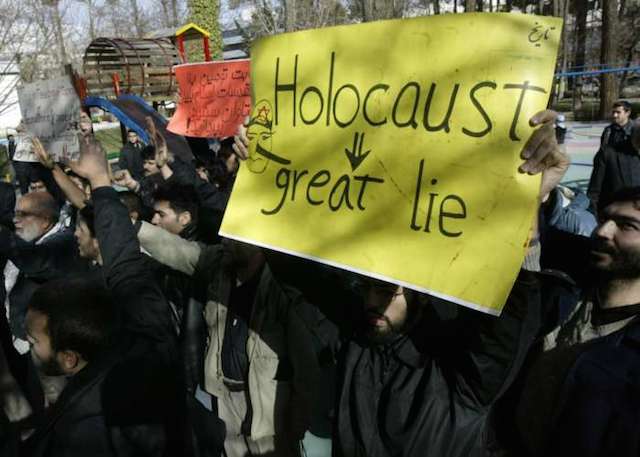How do we know the number of Jews killed in the Holocaust is six million, as opposed to six hundred thousand? What evidence exists that murdering of Jews was official Nazi policy and not the acts of rogue individuals? How do we know that gas chambers were used for mass murder?
Most people would never think to ask these questions. In popular history, it is taken as a given that six million Jews perished at the hands of the Nazi regime.
Nevertheless, Holocaust deniers question these facts. Some even go so far as to claim that a genocide against the Jewish people never took place, that any deaths of Jewish Europeans during World War II was the result of natural events in wartime. The president of Iran, Mahmoud Ahmadinejad, for example has made this exact argument repeatedly. Deniers argue that claims to the contrary are part of a historical lie perpetrated by Jewish leaders, political figures, and historians.


Help us keep Jewish knowledge accessible to millions of people around the world.
Your donation to My Jewish Learning fuels endless journeys of Jewish discovery. With your help, My Jewish Learning can continue to provide nonstop opportunities for learning, connection and growth.
Who’s Counting?
One of the most frequent challenges posed by the Holocaust deniers is calling into question the “6 million” figure. Various deniers claim the actual number is only a million or a few hundred thousand.
Holocaust denial proponents point to the World Almanac for proof. The 1940 edition listed the world’s Jewish population at 15,319,359. By the 1949 edition, deniers assert, that figure is listed as 15,713,638. How could six million, over one-third of all Jews in the world, be murdered and the population increase?
Historians immediately point out that the 1949 World Almanac does not list that figure for the world Jewish population. Instead, the increased number was taken from an erroneous Senate Judiciary Committee report in 1950. Anybody looking in the 1949 World Almanac would instead see the figure of 11,266,600, along with a revision of the 1939 population upwards to more than 16-and-a-half million.
Another argument stems from the change to a commemorative plaque at Auschwitz. Until 1994, the plaque read “Four million people suffered and died here at the hands of the Nazi murderers between the years 1940 and 1945.” In 1991, that plaque was replaced with a new one that listed only one and a half million victims, “a majority of them Jews.” Deniers quickly pointed to the revision as proof that the numbers were inflated.
Bradley Smith, a prominent denier who gained notoriety by sending ads to college newspapers questioning facts about the Holocaust, sent out an ad in 1992:
The Auschwitz State Museum has recently revised its half-century-old claim that 4 million humans were murdered there. The Museum now says maybe it was 1 million. But what proof does the Museum provide to document the 1 million figure? None! The communist propagandists who manage the museum have put on display piles of hair, boots and eyeglasses, etc. While such displays are effective propaganda devices, they are worthless as historical documentation for ‘gassings’ or a program of ‘extermination.’
Meanwhile, Revisionists want to know where those 3 million souls have been the last 45 years. Were they part of the fabled Six Million?
In fact, the actual numbers were inflated, but not by Jewish historians trying to guilt the world into compensation. The Soviets overstated the number of non-Jewish victims for propaganda purposes. A noted historian, Raul Hillberg, estimated just over a million deaths at Auschwitz. He did that in 1950, and estimates by historians such as him have been always been the scholarly basis for determining the number of victims.
Tactics Dissected
Debating whether the figure of six million is inflated is just tip of the iceberg. Other denial arguments center on the use of gas chambers in Nazi concentration camps. Still others question the role of top Nazi officials, pointing out that no document exists with Hitler’s signature that instructs, “Kill all the Jews.”
Additionally, there are other minor details of the Holocaust that come up for questioning. The piles of hair, boots, and other gleanings from the victims of concentration camps are often criticized. Some cite this as a propaganda creation rather than actual Nazi collections. Others have criticized Anne Frank‘s diary, contending it was a postwar forgery
Like the above theories, all Holocaust denial, reflects a specific approach. The primary goal is usually to undermine a specific claim by ignoring the whole body of historical evidence and instead targeting a single, sometimes obscure, fact. This is perhaps the defining tactic of Holocaust denial.
Deniers will pull a reference from the historical record and present it as impossible. These statements often sound legitimate and serve a dual purpose to the average listener. Doubt is cast upon the specific claim, and the onus is placed back on those who claim the Holocaust happened. If they can raise enough doubts about enough claims, deniers believe they can undermine the entire Holocaust narrative by eroding public certainty.
Take for example the use of Zyklon-B in concentration camp gas chambers. The Institute for Historical Review, a denial organization, refers to a confession from Rudolf Hoss, the Nazi commandant at Auschwitz: “Hoss said in his confession that his men would smoke cigarettes as they pulled the dead Jews out of the gas chambers ten minutes after gassing. Isn’t Zyklon-B explosive? Highly so. The Hoss confession is obviously false.”
Sounds plausible? Zyklon-B is explosive–so how does one account for the discrepancy here? To answer that, one needs to understand the minimal concentrations necessary for a gas to explode and terms such as “parts per million,” or point to the ventilation systems Nazis themselves installed in the gas chambers. By this point, however, deniers have reached their goal of planting doubt within their audience
It’s this approach, rather than extreme claims about Jewish conspiracies, that can find an audience even among fair minded individuals. Dr. Robert Faurisson, a former French academic, made his name in the denial community first by focusing on the “problem of the gas chambers.” He later would argue that the Holocaust is a “Zionist lie” and a “huge financial swindle of which the state of Israel is the principal beneficiary.” This reflects a common sentiment among deniers, that the Holocaust has been, at the very least, exaggerated in order to benefit Jews and Israel financially. Nevertheless, denial arguments don’t usually start with that conclusion. They end there.
Why Bother?
A more immediate question arises when looking at the efforts of Holocaust deniers against a mountain of testimonials, documents, and historical research. The Nizkor Project, an anti-denial group based out of Canada, puts simply puts it: “Given the evidence… why do people deny the Holocaust?”
Today, denial has largely been relegated to fringe hate groups, neo-Nazis, and blatant anti-Semites. So for the answer, it’s worth looking at what such groups themselves say on the subject. The Nizkor Project has an entire section of its website devoted to the statements of the National Socialist White People’s Party on denial. Their leader, Harold Covington, is quoted from a 1996 bulletin paraphrasing leading critic of Holocaust denial Deborah Lipstadt:
“The real purpose of Holocaust revisionism is to make National Socialism an acceptable political alternative again,” Covington summarizes. Then he adds, “I normally don’t agree with anything a Jew says, but I recall exclaiming, ‘Bingo! Got it in one! Give that lady a cigar!'”
Covington is quoted elsewhere as saying, “Take away the Holocaust and what do you have left? Without their precious Holocaust, what are the Jews? Just a grubby little bunch of international bandits and assassins and squatters who have perpetrated the most massive, cynical fraud in human history.”
Many see Holocaust denial as an anti-Semitic attempt to legitimize white power and hate group ideology. Though some deniers have attempted to minimize this reality and cloak their efforts in scholarship, their own statements reveal their primary motivations.
Still in the years just after the Holocaust, denial was less a blatantly anti-Semitic movement and more the outgrowth of extreme libertarianism, anti-war thinkers, and perpetrators themselves attempting to avoid blame.
The father of the denial movement was Harry Elmer Barnes. Hardly a raving anti-Semite, he was once a respected historian. He was an anti-war writer in the years prior to World War II, and after the war based his criticism of U.S. involvement on libertarian principles. It was these positions that led Barnes to write off the Holocaust as a piece of Allied propaganda — something most other libertarians rejected even while embracing his other writings.
However clear the historical record may be, it remains forever vulnerable to popular ignorance and apathy. The tactic of deniers is to pose questions, raise doubts, and ignore historical evidence. While informed people might call Holocaust denial ridiculous, their clear strategy and goals are far from that.


